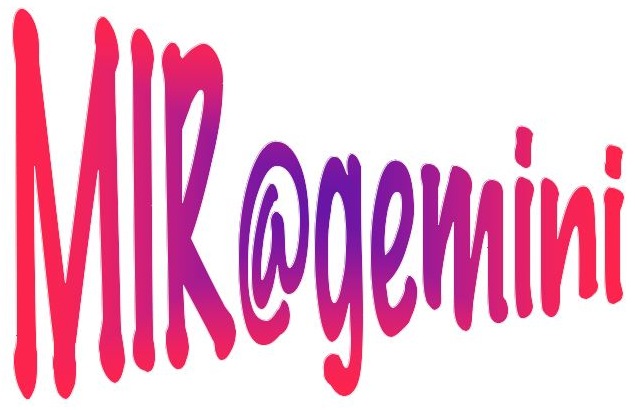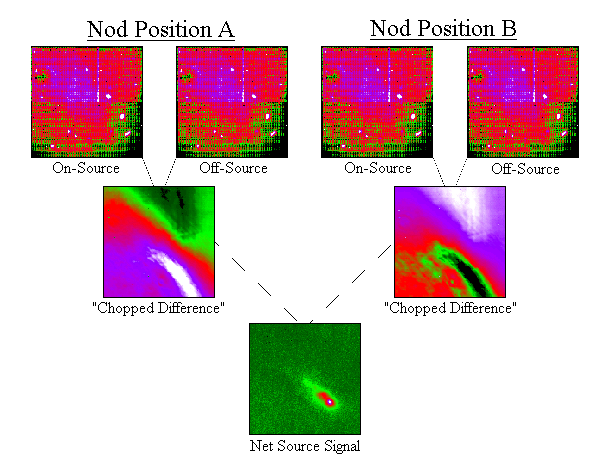
| You are in: Instruments > MIR > Chopping and Nodding |  |
 |
Chopping and Nodding |
Ground-based observing in the mid-infrared (about 3 to 25 µm wavelength) is much different than observing in the optical or near-infrared because of the very large thermal background flux that peaks near 10 µm. Even on an infrared-optimized telescope like Gemini, the background is large compared to the flux of most astronomical sources. Therefore, when observing in imaging and low-resolution spectroscopy modes with T-ReCS and Michelle, "chopping" and "nodding" techniques are needed to subtract the background to high precision.
Consider the case of the Gemini telescope with aperture diameter = 8.1 m, temperature = 273 K, and emissivity = 0.03. At the focal plane, at 10 µm wavelength, the thermal background flux density from the telescope itself will be about 144 Jy per square arcsecond. (1 Jansky = 10-26 W/m2/Hz.) For simplicity we will ignore the background flux from the sky — in the most transparent parts of the 8–13 µm window this could be below 20% of the telescope flux, but in the 20 µm window where the transmission is very low it could be several times higher. The flux density of the bright mid-infrared standard Alpha Boo, for comparison, is about 600 Jy at 10 µm. If 50% of the starlight is concentrated in a 0.7 arcsec diameter circle, then only 300/(300+147) = 0.67 of the total flux in that circle will be from the star.
The accuracy to which background flux can be subtracted is limited by several sources of noise: shot noise of the photon flux itself, "1/f" noise due to variations in the background caused by temperature drifts and clouds, and read noise and 1/f noise in the detector. The principal goal is to reach background-limited performance, where the photon noise dominates the other sources.
In our example case, 144 Jy/arcsec2 corresponds to 2.2e8 photons/m2/s/µm/arcsec2 at 10.0 µm. With a 1 micron bandpass filter, 0.084" × 0.084" pixels, and an instrumental throughput of 0.7, the photon flux at the detector is 5.5e7 photons/sec/pixel. With a quantum efficiency of 0.25, the rate that electrons are generated in the detector is 1.4e7 e-/sec/pixel. In a 10 second integration (which would be composed of several hundred ~20 msec frames), the number of accumulated electrons is 1.4e8 and the shot noise is the square root: 11,800. Therefore, the other noise components must be < 11,800 e-, or 1 part in 11,800 of the absolute signal, for this 10 second integration to be background limited.
1/f sky noise is suppressed with a technique called "chopping," in
which the telescope's secondary mirror is oscillated in a square-wave
pattern at a frequency of several Hz. The detector alternately views
two fields or "beams" on the sky; we will call these beams A and B.
At the start of an integration, beam A is "on-source," containing the
object under observation, and beam B is "off- source", containing
blank sky. Thus we have two measurements: (signal1 = source + skyA),
and (signal2 = skyB). Computing (signal1 - signal2) cancels most, but
not all, of the sky emission. In practice, because the optical path
through the telescope optics is different for the two chop positions,
the background level is also slightly different (skyA != skyB). To
completely remove the background, therefore, the telescope is "nodded"
periodically (~ 2 - 4 times per minute) to move the source from Beam A
to Beam B, and the quantities (signal3 = skyA) and (signal4 = source +
skyB) are recorded. By computing:
( signal1 - signal2) + ( signal4 - signal3)
= ((source + skyA) - skyB ) + ((source + skyB) - skyA )
= 2 * source,
This scenario is often complicated by the presence of astronomical sources in the "off-source" beams, so that the signal level of "skyA", for example, changes when the telescope nods. A judicious choice of chopping amplitude and angle is often necessary to avoid background-subtraction problems in crowded fields.
With modern imaging detectors, one might think that nodding alone may be sufficient to subtract the background, especially in the case of imaging a nearly point-like object where the surrounding field can be used to zero the sky. Several groups have attempted this, but each have found that the background varies so irregularly over the field after just a few seconds that it cannot be modeled and subtracted to better than 1 part in 10,000. So, all groups with mid-IR imaging systems continue to chop and nod. High resolution spectroscopic work, where the contrast between an emission line and the background can be much higher, is often done without chopping.
Example OSCIR images taken in the chop & nod mode at IRTF (provided by C. Telesco, R. Pina, and R.S. Fisher at University of Florida.)

(Top) Four raw signal images which are coadditions of ~15,000 20 msec frames. The integration time for each image is ~ 5 minutes. The mean signal level is ~ 2.2e11 e-.
(Middle) "Chopped-Difference" images constructed from (signal1 - signal2) and (signal4 - signal3). The peak-valley variation is ~ 2e9 e-, only 1% of the absolute signal but still a few orders of magnitude above the background limit of 4.7e5.
(Bottom) The final "Net Source Signal" image showing NGC 253. The signal at the peak of the galaxy's nucleus is 6.0e7 e-. The noise level is about 6.6e5 e-/pixel, in good agreement with the expected background-limited performance.
Last update 2006 August 22; Rachel Mason. Original
page by Tom Hayward